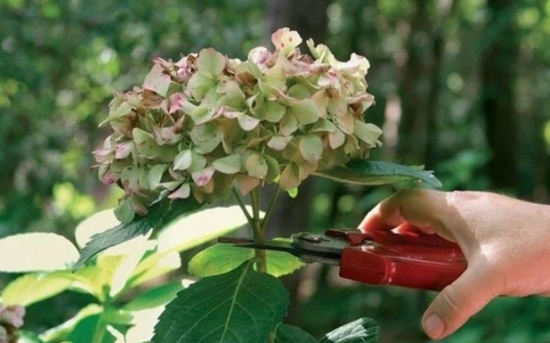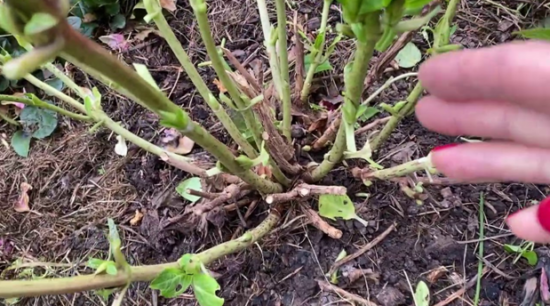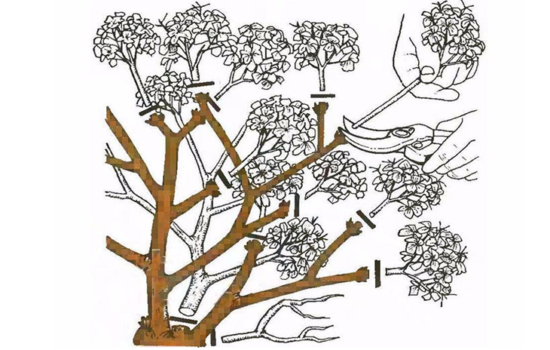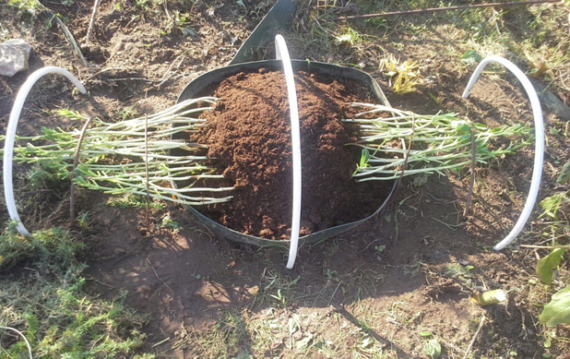Rules for pruning large-leaved hydrangea for lush flowering
Large-leaved hydrangea (hydrangeamacrophylla) is the leader in the beauty of flowering among crop species. A characteristic feature is the inflorescences of bright pink, blue, lilac flowers, the color of which can be changed by agricultural techniques.
Pruning hydrangea is a mandatory care procedure that ensures the splendor of flowering and decorative appearance of the seedling in the next season. To achieve optimal results during the procedure, take into account the plant variety. The species includes varieties that bloom only on last season's shoots, and remontant varieties that are capable of laying flowering buds on last year's and new branches. In this regard, pruning of ordinary and remontant varieties of hydrangea is carried out differently.
The article covers in detail all the nuances of spring and autumn pruning of large-leaved hydrangea, which will help novice gardeners achieve lush flowering of these beautiful shrubs in their garden.
When is it better to prune large-leaved hydrangea, in spring or autumn?
Spring-autumn pruning of hydrangea is carried out based on the variety (remontant or non-remontant). The main pruning is autumn. Has formative, rejuvenating, thinning, sanitary functions.
You should not prune your hydrangea bush immediately after flowering. This will trigger the growth of new shoots that will not survive the winter. The procedure is carried out in late autumn, before the first frost.
Important! The basic rule for pruning large-leaved hydrangea is to preserve as much of last year's woody shoots as possible. flower buds will develop on them.
Spring pruning of large-leaved hydrangea
With the onset of stable warmth, the overwintered crop is gradually freed from shelter and the bent stems are waited for to straighten.You can tie them to pegs, giving them a vertical position.
Spring pruning of large-leaved hydrangea is carried out in the phase of bud awakening. If you start the procedure earlier, sap flow will begin, the plant will lose a lot of moisture and may dry out.
The purpose of spring pruning in sanitary care. They cut out branches that did not survive the winter: frozen, broken, withered. The frozen tops of healthy shoots are removed up to the first upper bud.
If desired, light formative pruning is done to give the seedling a compact shape. A few skeletal branches and 4-5 last year's branches are left, the rest are removed.
It is allowed to shorten several shoots of the current year to 2-3 buds on remontant varieties in order to provoke the growth of lateral stems and make the bush more luxuriant.
|
Macrophyll after sanitary pruning |
Don't forget to read:
Planting and caring for large-leaved hydrangea in open ground ⇒
Pruning large-leaved remontant hydrangea in autumn
Remontant varieties of large-leaved hydrangeas bloom on shoots of the previous and current year. The more buds left on the stems, the more abundant the flowering will be.
If the plant is left to overwinter in the open ground, to make it easier to cover, many gardeners remove 1/3 of everything, even new, well-ripened shoots. Only 3 internodes are left. In this case, next year flowering will be possible only on these branches.
|
Trimming faded inflorescences on a remontant variety |
There is no point in trimming a hydrangea bush this way if it is well covered. It is enough to remove all flower stalks along with the first pair of leaves.
Fallen stems growing horizontally, as well as crooked, thin, multidirectional shoots are cut off.
Pruning large-leaved non-remontant hydrangea in the fall
Large-leaved non-remontant hydrangeas bloom only on last year's shoots. If they are not preserved, there will be no flowering next year.
Important! In order not to confuse one-year-old and two-year-old shoots, novice gardeners mark them with multi-colored strings.
|
Pruning non-repairing Hydrangeamacrophylla in autumn |
Pruning is carried out in October-November, before the onset of stable frosts:
- The branches that bloomed this year are shortened by cutting off the faded inflorescences to the first pair of leaves. You can cut out several of these shoots at the base if the green pet is too thick.
- The remaining foliage is cut off with pruning shears and burned.
- Cut out branches creeping along the ground. To ensure breathability, branches directed into the bush are also cut off.
- Stems with many lateral branches and traces of previous trimmings are trimmed.
- Break out dried stumps from old branches.
Helpful information! An old bush that has never been pruned is rejuvenated by completely removing all the branches. The plant will be stimulated to a new life cycle, and in a year or two the hydrangea will delight you with full flowering.
Preparing and covering large-leaved hydrangea for the winter
Large-leaved hydrangea is a beauty that requires warmth, forcing gardeners to especially carefully prepare it for winter with severe frosts and thaws. Depending on the variety, this species blooms on shoots of the previous and current year; to preserve branches with flowering buds, they must be covered for the winter.
Hydrangea is prepared for wintering in warm September weather. At this time, the plant does not even think about shedding its leaves.
- Using scissors, cut out the lower leaves and those that touch the ground.Firstly, leaves lying on the soil can acquire various fungal diseases from it. Secondly, the bush does not spend additional energy on the development of unnecessary greenery, but directs nutrition to the development of the root system.
- Inside, all the dried stumps of last year's shoots are cut off.
- Feed with complex fertilizer for hydrangeas. The substance is scattered into the tree trunk circle according to the instructions and embedded in the soil. Superphosphate or any autumn fertilizer for flowers is also suitable.
- Water-recharging irrigation is done, 20 liters of water are consumed per plant. So that the liquid does not spread over the surface, but goes to the roots, an earthen roller is made around the seedling.
- Protective treatment of the soil and above-ground parts of the plant is carried out with copper-containing preparations against diseases and pests. Use iron sulfate, copper sulfate, and Bordeaux mixture.
- To protect the root system from the cold, the ground is covered with 3 buds. The method will help protect the lower part of the bush in case of severe frosts or damage to the shelter from below. They use dry oak leaves (it retains heat well), dry sawdust, and acidic peat.
- Large specimens are tied and bent to the ground, having previously divided it in half. Using arcs or staples, smoothly press one half to the ground, then the other. The center of the plant should not be bare.
|
Preparing for winter |
What can a shelter be made from?
The prepared bush is covered until the onset of night frosts; they are destructive for the buds that the plant has established. You can do without insulation in the south of the country, in the Krasnodar Territory and Crimea. The timing of shelter depends on local weather conditions.
White dense lutrasil in 2 layers is thrown onto the arcs installed next to the crop, the dome is pulled, and pressed down on the ground with boards and bricks.To prevent the covering material from getting wet from rain before the onset of frost and snow, it is covered with a film on top.
Important! If the temperature becomes abnormally warm in winter, you need to make a small gap at the bottom for ventilation by removing one or two stones.
|
Shelter made of lutrasil |
In regions with harsh winters, it is safer to use a frame made of mesh or boards, covered on the sides with covering material on top. Additional insulation is poured inside the fence: bark, dry leaves, straw. In warm winter weather, the ceiling of the frame is opened for ventilation.
|
Frame shelter with insulation inside |
How to properly prune indoor large-leaved hydrangea in pots
In autumn, after the inflorescences have withered and the leaves have dropped. carry out sanitary and formative pruning:
- Weak, thin, crooked shoots are removed.
- Trim faded inflorescences to the nearest pair of leaves.
- To control the growth and size of the green pet, the strong stems of last year's season are shortened, leaving 2-3 internodes. This stimulates the bush to grow wider. New side stems will begin to form from the axils. The more often this pruning is done, the more magnificent the plant becomes. Cut off apical stems are ready-made planting material for propagating seedlings by cuttings.
- The branches of the current season are not touched; flower buds are laid in them for future flowering in the next season.
In the spring, thinning pruning is carried out, and shoots that are too elongated and weak are removed.
|
Autumn pruning of domestic hydrangeamacrophylla |
Important! Potted indoor growing is only suitable for large-leaved hydrangeas.









 CUCUMBERS NEVER GET SICK, I'VE BEEN USING ONLY THIS FOR 40 YEARS! I SHARE A SECRET WITH YOU, CUCUMBERS ARE LIKE THE PICTURE!
CUCUMBERS NEVER GET SICK, I'VE BEEN USING ONLY THIS FOR 40 YEARS! I SHARE A SECRET WITH YOU, CUCUMBERS ARE LIKE THE PICTURE! You can dig a bucket of potatoes from each bush. Do you think these are fairy tales? Watch the video
You can dig a bucket of potatoes from each bush. Do you think these are fairy tales? Watch the video
 How our fellow gardeners work in Korea. There is a lot to learn and just fun to watch.
How our fellow gardeners work in Korea. There is a lot to learn and just fun to watch. Eye trainer. The author claims that with daily viewing, vision is restored. They don't charge money for views.
Eye trainer. The author claims that with daily viewing, vision is restored. They don't charge money for views. A 3-ingredient cake recipe in 30 minutes is better than Napoleon. Simple and very tasty.
A 3-ingredient cake recipe in 30 minutes is better than Napoleon. Simple and very tasty. Therapeutic exercises for cervical osteochondrosis. A complete set of exercises.
Therapeutic exercises for cervical osteochondrosis. A complete set of exercises. Which indoor plants match your zodiac sign?
Which indoor plants match your zodiac sign? What about them? Excursion to German dachas.
What about them? Excursion to German dachas.